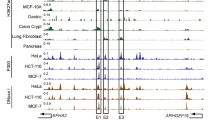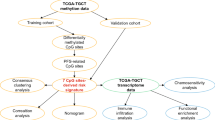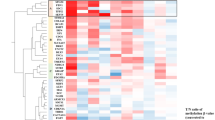Abstract
During the recent years lysine methyltransferase Set7/9 ((Su(var)-3–9, Enhancer-of-Zeste, Trithorax) domain containing protein 7/9) has emerged as an important regulator of different transcription factors. In this study, we report a novel function for Set7/9 as a critical co-activator of E2 promoter-binding factor 1 (E2F1)-dependent transcription in response to DNA damage. By means of various biochemical, cell biology, and bioinformatics approaches, we uncovered that cell-cycle progression through the G1/S checkpoint of tumour cells upon DNA damage is defined by the threshold of expression of both E2F1 and Set7/9. The latter affects the activity of E2F1 by indirectly modulating histone modifications in the promoters of E2F1-dependent genes. Moreover, Set7/9 differentially affects E2F1 transcription targets: it promotes cell proliferation via expression of the CCNE1 gene and represses apoptosis by inhibiting the TP73 gene. Our biochemical screening of the panel of lung tumour cell lines suggests that these two factors are critically important for transcriptional upregulation of the CCNE1 gene product and hence successful progression through cell cycle. These findings identify Set7/9 as a potential biomarker in tumour cells with overexpressed E2F1 activity.
Similar content being viewed by others
Log in or create a free account to read this content
Gain free access to this article, as well as selected content from this journal and more on nature.com
or
Abbreviations
- DDR:
-
DNA damage response
- Set7/9:
-
(Su(var)-3–9, Enhancer-of-Zeste, Trithorax) domain containing protein 7/9
- E2F1:
-
E2 promoter-binding factor 1
- KMTase:
-
lysine methyltransferase
- TAF10:
-
TATA box binding protein (TBP)-associated factor, 30 kDa
- ERα:
-
oestrogen receptor
- PCAF:
-
P300/CBP-associated factor
- Rb:
-
retinoblastoma protein
- Cdk:
-
cyclin-dependent kinase
- BrdU:
-
bromodeoxyuridine
- siRNA:
-
small interfering RNA
- shRNA:
-
short hairpin RNA
- ChIP:
-
chromatin immunoprecipitation
- HDAC:
-
histone deacetylase
- HSP90:
-
heat shock protein 90
- PARP:
-
poly (ADP-ribose) polymerase
- RPMI:
-
Roswell Park Memorial Institute
- FBS:
-
foetal bovine serum
- DMEM:
-
Dulbecco’s modified Eagle’s medium
- RIPA:
-
radioimmunoprecipitation assay
- SDS-PAGE:
-
SDS-polyacrylamide gel electrophoresis
- PBS:
-
phosphate buffer saline
- BSA:
-
bovine serum albumin
- FACS:
-
fluorescence-activated cell sorting
References
Morgunkova A, Barlev NA . Lysine methylation goes global. Cell Cycle 2006; 5: 1308–1312.
Su IH, Tarakhovsky A . Lysine methylation and 'signaling memory'. Curr Opin Immunol 2006; 18: 152–157.
Pradhan S, Chin HG, Esteve PO, Jacobsen SE . SET7/9 mediated methylation of non-histone proteins in mammalian cells. Epigenetics 2009; 4: 383–387.
Nishioka K, Rice JC, Sarma K, Erdjument-Bromage H, Werner J, Wang Y et al. PR-Set7 is a nucleosome-specific methyltransferase that modifies lysine 20 of histone H4 and is associated with silent chromatin. Mol Cell 2002; 9: 1201–1213.
Wang H, Cao R, Xia L, Erdjument-Bromage H, Borchers C, Tempst P et al. Purification and functional characterization of a histone H3-lysine 4-specific methyltransferase. Mol Cell 2001; 8: 1207–1217.
Ivanov GS, Ivanova T, Kurash J, Ivanov A, Chuikov S, Gizatullin F et al. Methylation-acetylation interplay activates p53 in response to DNA damage. Mol Cell Biol 2007; 27: 6756–6769.
Lehnertz B, Rogalski JC, Schulze FM, Yi L, Lin S, Kast J et al. p53-dependent transcription and tumor suppression are not affected in Set7/9-deficient mice. Mol Cell 2011; 43: 673–680.
Campaner S, Spreafico F, Burgold T, Doni M, Rosato U, Amati B et al. The methyltransferase Set7/9 (Setd7) is dispensable for the p53-mediated DNA damage response in vivo. Mol Cell 2011; 43: 681–688.
Kouskouti A, Scheer E, Staub A, Tora L, Talianidis I . Gene-specific modulation of TAF10 function by SET9-mediated methylation. Mol Cell 2004; 14: 175–182.
Subramanian K, Jia D, Kapoor-Vazirani P, Powell DR, Collins RE, Sharma D et al. Regulation of estrogen receptor alpha by the SET7 lysine methyltransferase. Mol Cell 2008; 30: 336–347.
Ea CK, Baltimore D . Regulation of NF-kappaB activity through lysine monomethylation of p65. Proc Natl Acad Sci USA 2009; 106: 18972–18977.
Masatsugu T, Yamamoto K . Multiple lysine methylation of PCAF by Set9 methyltransferase. Biochem Biophys Res Commun 2009; 381: 22–26.
Yang J, Huang J, Dasgupta M, Sears N, Miyagi M, Wang B et al. Reversible methylation of promoter-bound STAT3 by histone-modifying enzymes. Proc Natl Acad Sci USA 2010; 107: 21499–21504.
Oudhoff MJ, Freeman SA, Couzens AL, Antignano F, Kuznetsova E, Min PH et al. Control of the hippo pathway by Set7-dependent methylation of Yap. Dev Cell 2013; 26: 188–194.
Wang D, Zhou J, Liu X, Lu D, Shen C, Du Y et al. Methylation of SUV39H1 by SET7/9 results in heterochromatin relaxation and genome instability. Proc Natl Acad Sci USA 2013; 110: 5516–5521.
Chuikov S, Kurash Y, Wilson JR, Xiao B, Justin N, Ivanov G et al. Regulation of p53 activity through lysine methylation. Nature 2004; 432: 353–360.
Kontaki H, Talianidis I . Lysine methylation regulates E2F1-induced cell death. Mol Cell 2010; 39: 152–160.
Agarwal ML, Agarwal A, Taylor WR, Stark GR . p53 controls both the G2/M and the G1 cell cycle checkpoints and mediates reversible growth arrest in human fibroblasts. Proc Natl Acad Sci USA 1995; 92: 8493–8497.
Linke SP, Clarkin KC, Di Leonardo A, Tsou A, Wahl GM . A reversible, p53-dependent G0/G1 cell cycle arrest induced by ribonucleotide depletion in the absence of detectable DNA damage. Genes Dev 1996; 10: 934–947.
Di Leonardo A, Linke SP, Clarkin K, Wahl GM . DNA damage triggers a prolonged p53-dependent G1 arrest and long-term induction of Cip1 in normal human fibroblasts. Genes Dev 1994; 8: 2540–2551.
Geske FJ, Nelson AC, Lieberman R, Strange R, Sun T, Gerschenson LE . DNA repair is activated in early stages of p53-induced apoptosis. Cell Death Differ 2000; 7: 393–401.
Johnson DG, Schwarz JK, Cress WD, Nevins JR . Expression of transcription factor E2F1 induces quiescent cells to enter S phase. Nature 1993; 365: 349–352.
Polager S, Ginsberg D . p53 and E2f: partners in life and death. Nat Rev Cancer 2009; 9: 738–748.
Chellappan SP, Hiebert S, Mudryj M, Horowitz JM, Nevins JR . The E2F transcription factor is a cellular target for the RB protein. Cell 1991; 65: 1053–1061.
Nevins JR, Chellappan SP, Mudryj M, Hiebert S, Devoto S, Horowitz J et al. E2F transcription factor is a target for the RB protein and the cyclin A protein. Cold Spring Harb Symp Quant Biol 1991; 56: 157–162.
Helin K, Harlow E, Fattaey A . Inhibition of E2F-1 transactivation by direct binding of the retinoblastoma protein. Mol Cell Biol 1993; 13: 6501–6508.
Helin K, Ed H . The retinoblastoma protein as a transcriptional repressor. Trends Cell Biol 1993; 3 (2): 43–46.
Berthet C, Klarmann KD, Hilton MB, Suh HC, Keller JR, Kiyokawa H et al. Combined loss of Cdk2 and Cdk4 results in embryonic lethality and Rb hypophosphorylation. Dev Cell 2006; 10: 563–573.
Braden WA, Lenihan JM, Lan Z, Luce KS, Zagorski W, Bosco E et al. Distinct action of the retinoblastoma pathway on the DNA replication machinery defines specific roles for cyclin-dependent kinase complexes in prereplication complex assembly and S-phase progression. Mol Cell Biol 2006; 26: 7667–7681.
Koff A, Giordano A, Desai D, Yamashita K, Harper JW, Elledge S et al. Formation and activation of a cyclin E-cdk2 complex during the G1 phase of the human cell cycle. Science 1992; 257: 1689–1694.
Braden WA, McClendon AK, Knudsen ES . Cyclin-dependent kinase 4/6 activity is a critical determinant of pre-replication complex assembly. Oncogene 2008; 27: 7083–7093.
Dyson N . The regulation of E2F by pRB-family proteins. Genes Dev 1998; 12: 2245–2262.
Ren B, Cam H, Takahashi Y, Volkert T, Terragni J, Young RA et al. E2F integrates cell cycle progression with DNA repair, replication, and G(2)/M checkpoints. Genes Dev 2002; 16: 245–256.
DeGregori J, Kowalik T, Nevins JR . Cellular targets for activation by the E2F1 transcription factor include DNA synthesis- and G1/S-regulatory genes. Mol Cell Biol 1995; 15: 4215–4224.
Pan H, Yin C, Dyson NJ, Harlow E, Yamasaki L, Van Dyke T . Key roles for E2F1 in signaling p53-dependent apoptosis and in cell division within developing tumors. Mol Cell 1998; 2: 283–292.
Taura M, Suico MA, Fukuda R, Koga T, Shuto T, Sato T et al. MEF/ELF4 transactivation by E2F1 is inhibited by p53. Nucleic Acids Res 2011; 39: 76–88.
Marouco D, Garabadgiu AV, Melino G, Barlev NA . Lysine-specific modifications of p53: a matter of life and death? Oncotarget 2013; Vol 4: 1556–1571.
Mittenberg AG, Moiseeva TN, Barlev NA . Role of proteasomes in transcription and their regulation by covalent modifications. Front Biosci 2008; 13: 7184–7192.
Moiseeva TN, Bottrill A, Melino G, Barlev NA . DNA damage-induced ubiquitylation of proteasome controls its proteolytic activity. Oncotarget 2013; 4: 1338–1348.
Esteve PO, Chin HG, Benner J, Feehery GR, Samaranayake M, Horwitz GA et al. Regulation of DNMT1 stability through SET7-mediated lysine methylation in mammalian cells. Proc Natl Acad Sci USA 2009; 106: 5076–5081.
Yang XD, Huang B, Li M, Lamb A, Kelleher NL, Chen LF . Negative regulation of NF-kappaB action by Set9-mediated lysine methylation of the RelA subunit. EMBO J 2009; 28: 1055–1066.
Kleiblova P, Shaltiel IA, Benada J, Sevcik J, Pechackova S, Pohlreich P et al. Gain-of-function mutations of PPM1D/Wip1 impair the p53-dependent G1 checkpoint. J Cell Biol 2013; 201: 511–521.
Errico A, Deshmukh K, Tanaka Y, Pozniakovsky A, Hunt T . Identification of substrates for cyclin dependent kinases. Adv Enzyme Regul 2010; 50: 375–399.
Dulic V, Kaufmann WK, Wilson SJ, Tlsty TD, Lees E, Harper JW et al. p53-dependent inhibition of cyclin-dependent kinase activities in human fibroblasts during radiation-induced G1 arrest. Cell 1994; 76: 1013–1023.
Evans T, Rosenthal ET, Youngblom J, Distel D, Hunt T . Cyclin: a protein specified by maternal mRNA in sea urchin eggs that is destroyed at each cleavage division. Cell 1983; 33: 389–396.
Lezina L, Purmessur N, Antonov AV, Ivanova T, Karpova E, Krishan K et al. miR-16 and miR-26a target checkpoint kinases Wee1 and Chk1 in response to p53 activation by genotoxic stress. Cell Death Dis 2013; 4: e953.
Wunderlich M, Berberich SJ . Mdm2 inhibition of p53 induces E2F1 transactivation via p21. Oncogene 2002; 21: 4414–4421.
Kelly RD, Cowley SM . The physiological roles of histone deacetylase (HDAC) 1 and 2: complex co-stars with multiple leading parts. Biochem Soc Trans 2013; 41: 741–749.
Hallstrom TC, Mori S, Nevins JR . An E2F1-dependent gene expression program that determines the balance between proliferation and cell death. Cancer Cell 2008; 13: 11–22.
Johnson DG, Degregori J . Putting the oncogenic and tumor suppressive activities of E2F into context. Curr Mol Med 2006; 6: 731–738.
Antonov AV . BioProfiling.de: analytical web portal for high-throughput cell biology. Nucleic Acids Res 2011; 39: W323–W327.
Antonov AV, Knight RA, Melino G, Barlev NA, Tsvetkov PO . MIRUMIR: an online tool to test microRNAs as biomarkers to predict survival in cancer using multiple clinical data sets. Cell Death Differ 2013; 20: 367–367.
Eymin B, Gazzeri S, Brambilla C, Brambilla E . Distinct pattern of E2F1 expression in human lung tumours: E2F1 is upregulated in small cell lung carcinoma. Oncogene 2001; 20: 1678–1687.
Huang CL, Liu D, Nakano J, Yokomise H, Ueno M, Kadota K et al. E2F1 overexpression correlates with thymidylate synthase and survivin gene expressions and tumor proliferation in non small-cell lung cancer. Clin Cancer Res 2007; 13: 6938–6946.
Celardo I, Grespi F, Antonov A, Bernassola F, Garabadgiu AV, Melino G et al. Caspase-1 is a novel target of p63 in tumor suppression. Cell Death Dis 2013; 4: e645.
Black JC, Van Rechem C, Whetstine JR . Histone lysine methylation dynamics: establishment, regulation, and biological impact. Mol Cell 2012; 48: 491–507.
Saddic LA, West LE, Aslanian A, Yates JR 3rd, Rubin SM, Gozani O et al. Methylation of the retinoblastoma tumor suppressor by SMYD2. J Biol Chem 2010; 285: 37733–37740.
Huang J, Perez-Burgos L, Placek BJ, Sengupta R, Richter M, Dorsey JA et al. Repression of p53 activity by Smyd2-mediated methylation. Nature 2006; 444: 629–632.
Shi X, Kachirskaia I, Yamaguchi H, West LE, Wen H, Wang EW et al. Modulation of p53 function by SET8-mediated methylation at lysine 382. Mol Cell 2007; 27: 636–646.
Abu-Farha M, Lanouette S, Elisma F, Tremblay V, Butson J, Figeys D et al. Proteomic analyses of the SMYD family interactomes identify HSP90 as a novel target for SMYD2. J Mol Cell Biol 2011; 3: 301–308.
Burrows F, Zhang H, Kamal A . Hsp90 activation and cell cycle regulation. Cell Cycle 2004; 3: 1530–1536.
Xie Q, Bai Y, Wu J, Sun Y, Wang Y, Zhang Y et al. Methylation-mediated regulation of E2F1 in DNA damage-induced cell death. J Recept Signal Transduct Res 2011; 31: 139–146.
Muratani M, Kung C, Shokat KM, Tansey WP . The F box protein Dsg1/Mdm30 is a transcriptional coactivator that stimulates Gal4 turnover and cotranscriptional mRNA processing. Cell 2005; 120: 887–899.
Bartkova J, Horejsi Z, Koed K, Kramer A, Tort F, Zieger K et al. DNA damage response as a candidate anti-cancer barrier in early human tumorigenesis. Nature 2005; 434: 864–870.
Keyomarsi K, Tucker SL, Buchholz TA, Callister M, Ding Y, Hortobagyi GN et al. Cyclin E and survival in patients with breast cancer. N Engl J Med 2002; 347: 1566–1575.
Dapas B, Farra R, Grassi M, Giansante C, Fiotti N, Uxa L et al. Role of E2F1-cyclin E1-cyclin E2 circuit in human coronary smooth muscle cell proliferation and therapeutic potential of its downregulation by siRNAs. Mol Med 2009; 15: 297–306.
Acknowledgements
This work was supported by MRC and by the Russian Ministry of Education (11.G34.31.0069) to GM and the Russian Foundation for Basic Research (A_2013 13-04-01024) and the Programme in Molecular and Cellular Biology from the Russian Academy of Sciences to NB.
Author information
Authors and Affiliations
Corresponding author
Ethics declarations
Competing interests
The authors declare no conflict of interest.
Additional information
Edited by M Piacentini
Supplementary Information accompanies this paper on Cell Death and Differentiation website
Supplementary information
Rights and permissions
About this article
Cite this article
Lezina, L., Aksenova, V., Ivanova, T. et al. KMTase Set7/9 is a critical regulator of E2F1 activity upon genotoxic stress. Cell Death Differ 21, 1889–1899 (2014). https://doi.org/10.1038/cdd.2014.108
Received:
Revised:
Accepted:
Published:
Issue date:
DOI: https://doi.org/10.1038/cdd.2014.108
This article is cited by
-
The RNA-binding protein HuR is a novel target of Pirh2 E3 ubiquitin ligase
Cell Death & Disease (2021)
-
Long non-coding RNA LINC01194 promotes the proliferation, migration and invasion of lung adenocarcinoma cells by targeting miR-641/SETD7 axis
Cancer Cell International (2020)
-
SEMG1/2 augment energy metabolism of tumor cells
Cell Death & Disease (2020)
-
Biological processes and signal transduction pathways regulated by the protein methyltransferase SETD7 and their significance in cancer
Signal Transduction and Targeted Therapy (2018)
-
Human EHMT2/G9a activates p53 through methylation-independent mechanism
Oncogene (2017)



